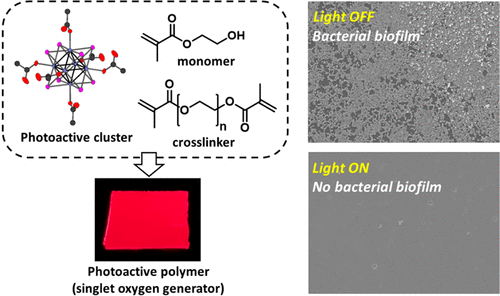当前位置:
X-MOL 学术
›
ACS Biomater. Sci. Eng.
›
论文详情
Our official English website, www.x-mol.net, welcomes your
feedback! (Note: you will need to create a separate account there.)
Photodynamic Inactivation of Staphylococcus aureus Biofilms Using a Hexanuclear Molybdenum Complex Embedded in Transparent polyHEMA Hydrogels
ACS Biomaterials Science & Engineering ( IF 5.4 ) Pub Date : 2020-11-19 , DOI: 10.1021/acsbiomaterials.0c00992 Noelia López-López 1 , Ignacio Muñoz Resta 1 , Rosa de Llanos 2 , Juan F. Miravet 1 , Maxim Mikhaylov 3 , Maxim N. Sokolov 3 , Sofía Ballesta 4, 5 , Isabel García-Luque 4, 5 , Francisco Galindo 1
ACS Biomaterials Science & Engineering ( IF 5.4 ) Pub Date : 2020-11-19 , DOI: 10.1021/acsbiomaterials.0c00992 Noelia López-López 1 , Ignacio Muñoz Resta 1 , Rosa de Llanos 2 , Juan F. Miravet 1 , Maxim Mikhaylov 3 , Maxim N. Sokolov 3 , Sofía Ballesta 4, 5 , Isabel García-Luque 4, 5 , Francisco Galindo 1
Affiliation

|
Three new photoactive polymeric materials embedding a hexanuclear molybdenum cluster (Bu4N)2[Mo6I8(CH3COO)6] (1) have been synthesized and characterized by means of Fourier-transform infrared spectroscopy (FTIR), thermogravimetric analysis (TGA), and emission spectroscopy. The materials are obtained in the format of transparent and thin sheets, and the formulations used to synthesize them are comprised of 2-hydroxyethyl methacrylate (HEMA), as a polymerizable monomer, and ethylene glycol dimethacrylate (EGDMA) or poly(ethylene glycol)dimethacrylate (PEGDMA), as cross-linkers. All the polymeric hydrogels generate singlet oxygen (1O2) upon irradiation with visible light (400–700 nm), as demonstrated by the reactivity toward two chemical traps of this reactive species (9,10-dimethylanthracene and 1,5-dihydroxynaphthalene). Some differences have been detected between the photoactive materials, probably attributable to variations in the permeability to solvent and oxygen. Notably, one of the materials resisted up to 10 cycles of photocatalytic oxygenation reactions of 1,5-dihydroxynaphthalene. All three of the polyHEMA hydrogels doped with 1 are efficient against S. aureus biofilms when irradiated with blue light (460 nm). The material made with the composition of 90% HEMA and 10% PEGDMA (Mo6@polymer-III) is especially easy to handle, because of its flexibility, and it achieves a notable level of bacterial population reduction (3.0 log10 CFU/cm2). The embedding of 1 in cross-linked polyHEMA sheets affords a protective environment to the photosensitizer against aqueous degradation while preserving the photochemical and photobactericidal activity.
中文翻译:

使用嵌入透明polyHEMA水凝胶中的六核钼配合物对金黄色葡萄球菌生物膜进行光动力灭活。
借助傅里叶变换红外光谱(FTIR),热重分析,合成了三种新型的嵌入六核钼簇(Bu 4 N)2 [Mo 6 I 8(CH 3 COO)6 ](1)的光敏聚合物材料。(TGA)和发射光谱。该材料以透明和薄片形式获得,用于合成它们的配方由甲基丙烯酸2-羟乙酯(HEMA)作为可聚合单体,以及乙二醇二甲基丙烯酸酯(EGDMA)或聚乙二醇二甲基丙烯酸酯组成(PEGDMA),作为交联剂。所有聚合水凝胶都会产生单线态氧(1 O2)在可见光(400-700 nm)照射下,如对该反应性物种(9,10-二甲基蒽和1,5-二羟基萘)对两个化学阱的反应性所证明。在光敏材料之间已经检测到一些差异,这可能归因于对溶剂和氧气的渗透性的变化。值得注意的是,其中一种材料可以抵抗10个1,5-二羟基萘的光催化氧化反应。掺杂有1的所有三种polyHEMA水凝胶在蓝光(460 nm)照射下均能有效抵抗金黄色葡萄球菌生物膜。由90%HEMA和10%PEGDMA组成的材料(Mo6 @ polymer-III由于其柔韧性好,因此特别易于处理,并且可以显着降低细菌种群水平(3.0 log 10 CFU / cm 2)。在交联的polyHEMA片材中嵌入1可为光敏剂提供保护环境,以防止水降解,同时保留光化学和光杀菌活性。
更新日期:2020-11-19
中文翻译:

使用嵌入透明polyHEMA水凝胶中的六核钼配合物对金黄色葡萄球菌生物膜进行光动力灭活。
借助傅里叶变换红外光谱(FTIR),热重分析,合成了三种新型的嵌入六核钼簇(Bu 4 N)2 [Mo 6 I 8(CH 3 COO)6 ](1)的光敏聚合物材料。(TGA)和发射光谱。该材料以透明和薄片形式获得,用于合成它们的配方由甲基丙烯酸2-羟乙酯(HEMA)作为可聚合单体,以及乙二醇二甲基丙烯酸酯(EGDMA)或聚乙二醇二甲基丙烯酸酯组成(PEGDMA),作为交联剂。所有聚合水凝胶都会产生单线态氧(1 O2)在可见光(400-700 nm)照射下,如对该反应性物种(9,10-二甲基蒽和1,5-二羟基萘)对两个化学阱的反应性所证明。在光敏材料之间已经检测到一些差异,这可能归因于对溶剂和氧气的渗透性的变化。值得注意的是,其中一种材料可以抵抗10个1,5-二羟基萘的光催化氧化反应。掺杂有1的所有三种polyHEMA水凝胶在蓝光(460 nm)照射下均能有效抵抗金黄色葡萄球菌生物膜。由90%HEMA和10%PEGDMA组成的材料(Mo6 @ polymer-III由于其柔韧性好,因此特别易于处理,并且可以显着降低细菌种群水平(3.0 log 10 CFU / cm 2)。在交联的polyHEMA片材中嵌入1可为光敏剂提供保护环境,以防止水降解,同时保留光化学和光杀菌活性。











































 京公网安备 11010802027423号
京公网安备 11010802027423号